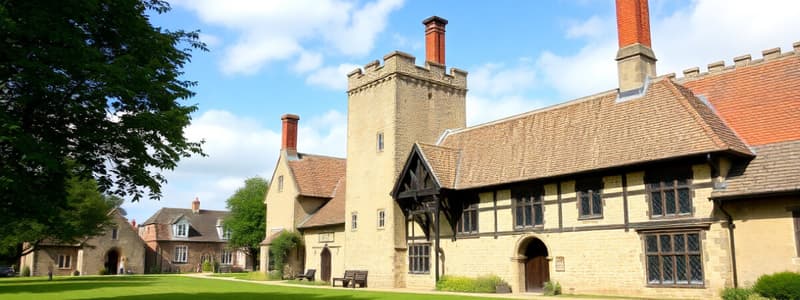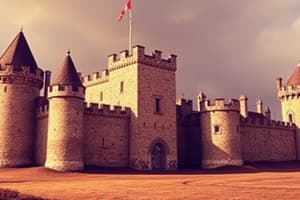Podcast
Questions and Answers
What was the primary purpose of the Domesday Book in Norman England?
What was the primary purpose of the Domesday Book in Norman England?
- To document the history of England's invasions
- To create a new legal system for the Normans
- To provide a detailed survey of land ownership (correct)
- To list the agricultural products of the time
Why did William reward his supporters with land instead of cash?
Why did William reward his supporters with land instead of cash?
- It was a strategy to secure loyalty and control (correct)
- Land was more valuable than money
- Cash was not accepted during that period
- England had little money to distribute
What problems prompted William to order a survey in December 1085?
What problems prompted William to order a survey in December 1085?
- Increased invasions from other countries
- Disunity among Norman landowners (correct)
- Rising bankruptcy among the nobility
- Native uprisings against Norman rule
What type of information was included in the survey ordered by William?
What type of information was included in the survey ordered by William?
What was one key function of the Domesday Book related to taxes?
What was one key function of the Domesday Book related to taxes?
What was the original name of the Domesday Book?
What was the original name of the Domesday Book?
Which assembly did William meet with to discuss land disputes?
Which assembly did William meet with to discuss land disputes?
What type of structures were recorded in the Domesday Book?
What type of structures were recorded in the Domesday Book?
In what way did the introduction of the Domesday Book affect taxation?
In what way did the introduction of the Domesday Book affect taxation?
What did invading England cost William, prompting the need for the Domesday Book?
What did invading England cost William, prompting the need for the Domesday Book?
Flashcards
What was the Domesday Book?
What was the Domesday Book?
The Domesday Book was a comprehensive written record of property ownership across England, completed in less than a year.
What was the Domesday Book initially called?
What was the Domesday Book initially called?
The Domesday Book was originally known as the Winchester Book.
Why did William the Conqueror create the Domesday Book?
Why did William the Conqueror create the Domesday Book?
William the Conqueror ordered the creation of the Domesday Book to address disputes over land ownership among his Norman supporters.
What information did the Domesday Book record?
What information did the Domesday Book record?
Signup and view all the flashcards
What types of buildings were recorded in the Domesday Book?
What types of buildings were recorded in the Domesday Book?
Signup and view all the flashcards
What was one of the main purposes of the Domesday Book?
What was one of the main purposes of the Domesday Book?
Signup and view all the flashcards
What other purpose did the Domesday Book serve?
What other purpose did the Domesday Book serve?
Signup and view all the flashcards
How did the Domesday Book contribute to William's control?
How did the Domesday Book contribute to William's control?
Signup and view all the flashcards
What overall information did the Domesday Book provide?
What overall information did the Domesday Book provide?
Signup and view all the flashcards
What did the Domesday Book symbolize?
What did the Domesday Book symbolize?
Signup and view all the flashcards
Study Notes
Norman Changes in England
- Normans implemented changes to English justice and taxation systems to consolidate their power.
- The Domesday Book, initially called the Winchester Book, was a comprehensive record of property ownership in England, completed within a year.
- William the Conqueror's conquest of England was costly, so loyal supporters were rewarded with land, not cash.
- Land disputes among Norman landowners emerged by 1085.
- William aimed to prevent disunity amongst his followers, having spent two decades establishing Norman control.
- In 1085, William convened the Great Council in Gloucester to address these issues.
- William ordered a survey to identify landowners, tenants, and land holdings, as well as other inhabitants and land use (woodland, meadow, livestock).
- Buildings (castles, churches, mills) were also to be recorded.
Domesday Book Purpose
- The Domesday Book served three main purposes:
- Facilitating tax collection (carefully to avoid popular anger)
- Determining the extent of land holdings.
- Assessing potential for increased taxation.
- The final question, "Can more (tax) be had than is had?", reveals William's intention to maximize revenue.
Studying That Suits You
Use AI to generate personalized quizzes and flashcards to suit your learning preferences.




